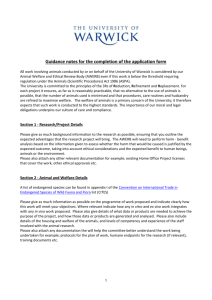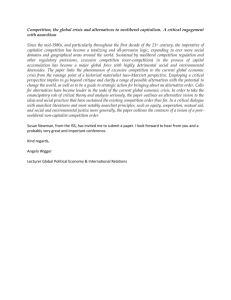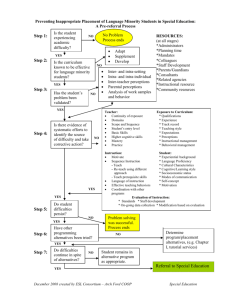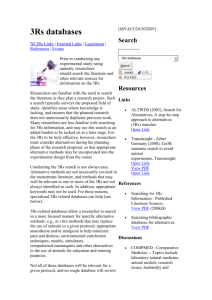Worksheet - Virginia Tech
advertisement
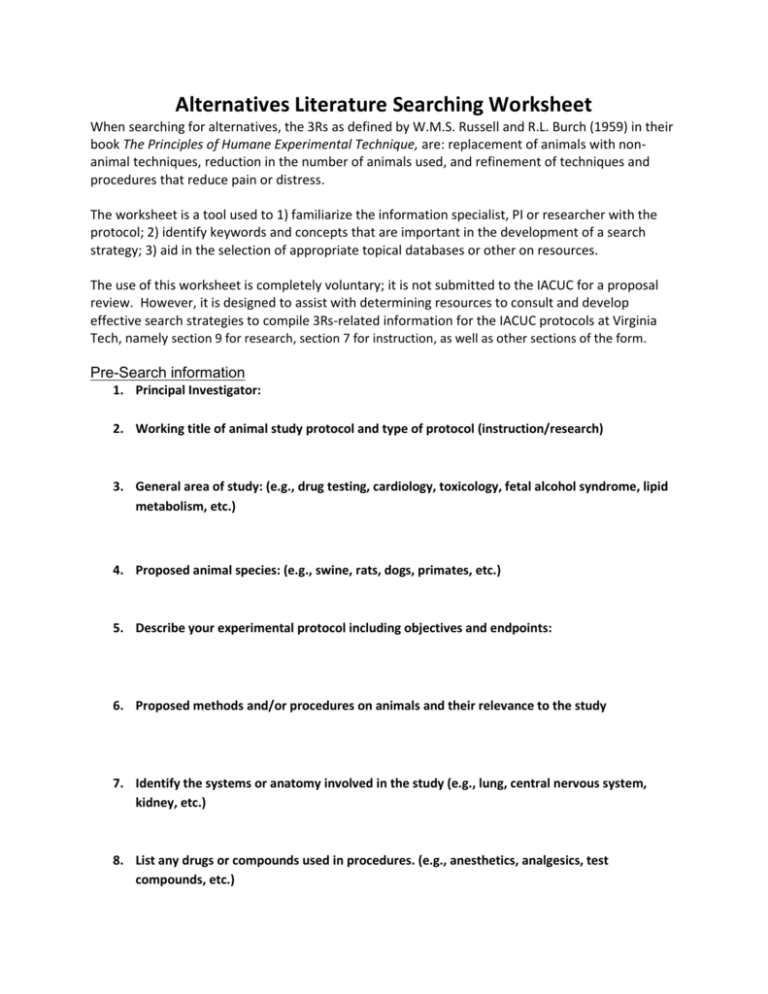
Alternatives Literature Searching Worksheet When searching for alternatives, the 3Rs as defined by W.M.S. Russell and R.L. Burch (1959) in their book The Principles of Humane Experimental Technique, are: replacement of animals with nonanimal techniques, reduction in the number of animals used, and refinement of techniques and procedures that reduce pain or distress. The worksheet is a tool used to 1) familiarize the information specialist, PI or researcher with the protocol; 2) identify keywords and concepts that are important in the development of a search strategy; 3) aid in the selection of appropriate topical databases or other on resources. The use of this worksheet is completely voluntary; it is not submitted to the IACUC for a proposal review. However, it is designed to assist with determining resources to consult and develop effective search strategies to compile 3Rs-related information for the IACUC protocols at Virginia Tech, namely section 9 for research, section 7 for instruction, as well as other sections of the form. Pre-Search information 1. Principal Investigator: 2. Working title of animal study protocol and type of protocol (instruction/research) 3. General area of study: (e.g., drug testing, cardiology, toxicology, fetal alcohol syndrome, lipid metabolism, etc.) 4. Proposed animal species: (e.g., swine, rats, dogs, primates, etc.) 5. Describe your experimental protocol including objectives and endpoints: 6. Proposed methods and/or procedures on animals and their relevance to the study 7. Identify the systems or anatomy involved in the study (e.g., lung, central nervous system, kidney, etc.) 8. List any drugs or compounds used in procedures. (e.g., anesthetics, analgesics, test compounds, etc.) 9. Any known species-specific considerations (e.g. housing, handling, behavior, etc) 10. Expected category of invasiveness: ___ A. Experiments on most invertebrates or on live isolates ___ B. Experiments which cause little or no discomfort or stress ___ C. Experiments which cause minor stress or pain of short duration ___ D. Experiments which cause moderate to severe distress or discomfort ___ E. Procedures which cause severe pain near, at, or above the pain tolerance threshold of unanesthetized conscious animals 11. List any potential alternatives (e.g., alternate models, modified techniques, housing modifications, modified restraint, in vitro methods, computer simulations, etc.) A. Replacement: B. Reduction: C. Refinement: Information Gathering 1. Database/resource selection (Choose those that are appropriate for the area of study): ____ Agricola ____ Biological Abstracts ____ Agriculture, Life Science, and ____ Cab Abstracts Natural Resources ____ Current Contexts Connect ____ Entrez from the NLM ____ PubMed/Medline ____ Science Citation Index (Web of Science) ____ VetCD (Index Veterinarius) ____ Other: 2. Database years of coverage: ______ to _____ 3. List key keywords/concepts using terminology from your responses to questions above (e.g. animal species and synonyms, such as cat or feline, FIV or feline immunodeficiency virus, drug testing, immune response, etc ). 4. Develop search strategies, using (), AND, OR, NOT, and/or truncation wildcards such as * ? ! ~ (swine OR pig* OR porcine) AND testing AND replacement NOT guinea ~ (rat* OR rattus) AND (stress) AND (hous* OR cage*) AND behavior?r 5. Search strategies and resources used: Keywords and concepts used in literature search for: Replacement Search Databases used to search Reduction Search Refinement Search 6. Other resources consulted, answer those that apply w/names, contact information, and job title/experience Other Resources consulted: Description Three Rs websites List: Experts consulted Laboratory animal veterinarian: Animal Welfare specialist: Other investigator: Statistician: Other: Information Review 1. Did the 3Rs search determine any possible Replacement alternatives? Replacement alternative No Yes If yes, describe and/or note citation: category Absolute Replacement Relative Replacement Other: 2. Did the 3Rs search determine any possible Reduction alternatives? Reduction alternative No Yes If yes, describe and/or note citation category Experimental Design Sample Size Calculation Animal Model Selection Telemetry Animal Supply Strategy Data Sharing Strategy Animal Re-use Strategy Other: 3. Did the 3Rs search determine any possible Refinement alternatives? Refinement alternative No Yes If yes, describe and/or note citation category Animal Handling Animal Housing Anesthesia Analgesia/Anesthesia Blood & Tissue Sampling Humane Endpoints Welfare Assessment Humane Killing Other: Information Synthesis Questions to assess if your 3Rs search is complete: 1. Is the proposed experiment or test duplicative? 2. Is there useful and current information about the proposed animal model? 3. Has a particular strain of animal been shown to be more sensitive to the effects that will be studied? 4. Are there any in vitro techniques that could replace the use of animals? 5. Could in vitro methods be incorporated into the protocol in any way to reduce the number of animals used (e.g. for early screening)? 6. Have any computer simulations been developed that relate to the study? 7. Have any statistical models been developed for use in this type of study, would these affect the design of the experiment? 8. Are there alternative animal models of lower sentience? 9. Is there information on the proposed model that might allow the use of fewer animals or might reduce the pain experienced by the animals? 10. Is there a way to decrease the level of invasiveness of the protocol without compromising the scientific objective? 11. Could the proposed anesthetics, analgesics, or other drugs pose a confounding influence on the experimental outcome? 12. Is there information about assessing welfare and the level of pain of the animals? Justification Table Justification Topic What are the potential benefits of the animal use? Explanation Why were possible Replacement alternatives rejected? Why is the choice of animal model appropriate? Why were possible Reduction alternatives rejected? What is the statistical rationale for sample sizes and sampling frequency? Why were possible Refinement alternatives rejected? Other: This worksheet adapted from http://www.nal.usda.gov/awic/alternatives/searches/altwksht.pdf and http://3rs.ccac.ca/documents/en/Animal_use_protocol_worksheet.doc. Last updated August 16, 2012.



